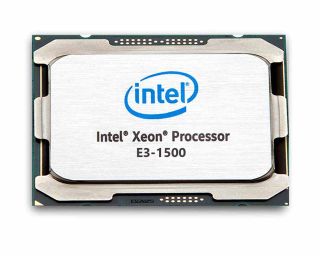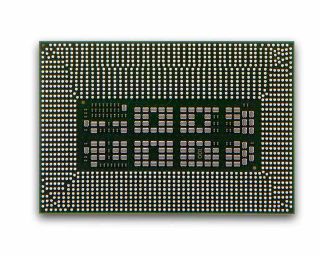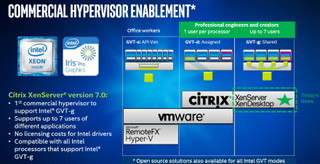Intel Launches Xeon E3-1500 v5 Family, Boosts Integrated Graphics, Memory
Internet video traffic is expected to increase 80 percent by 2020, and much of the new content requires intense graphical processing. The development of new and enhanced video services, such as 360 degree rotational streaming, VOD (Video On Demand), augmented reality and virtual reality, are leading to a veritable explosion in graphical processing workloads. Simultaneously, the video content delivery ecosystem is expanding to support higher resolution video, such as 4K and 8k UHD, and cable providers and content delivery networks are struggling to meet the increasing needs of end users.

Intel's new Xeon E3-1500 v5 steps in to satisfy the needs of these complex environments through the use of Intel Iris Pro P580 integrated graphical processors (IGP). The P580 IGP employs 72 Execution Units (EU) to expand upon the performance of the previous-generation Xeon E3 v4 family, which utilized Iris Pro P5700 and P3600 IGPs with 48 EU. Intel indicated that the new Iris Pro offers up to 26 percent more performance than the E3 v4 series.
Intel offers numerous solutions for various intensity levels, and the E3 v5 series slots in behind the Xeon E5 and E7 series, which offer the most performance through software transcoding. Intel also offers its Visual Compute Accelerator (VCA), which is a PCIe card that boasts three Intel E3 v4 processors, and it is natural to assume that the company will offer a new VCA version with its new E3 v5 progeny on board. Intel also offers the Altera Arria 10 FPGA for customized applications. The industry largely employs customized architectures that leverage ASICs, FPGAs or fixed-function DSPs for video processing, while Intel positions the E3 v5 series as a more general purpose platform.
The Intel E3 v5 adds a new hardware acceleration tool with its Quick Sync Video, which powers demanding real-time HEVC encoding tasks to speed HD and UHD video transcoding. Intel cites impressive numbers from the Quick Sync addition, such as the ability to process up to two real-time 4K 30 FPS video streams and up to 15 1080p 30 FPS steams. Intel also claims that it provides superior power efficiency metrics in comparison to PCIe-based graphics accelerators. HEVC provides up to double the compression with increased video quality at the same bitrate. Intel also notes an increase of up to 26 percent for 3D Mark 11 performance in remote environments.
Performance Optimized
| Intel Xeon E3 Family | E3-1585 v5 | E3-1585L v5 | E3-1565L v5 | E3-1285 v4 | E3-1285L v4 | E3-1265L v4 |
|---|---|---|---|---|---|---|
| Microarchitecture | Skylake | Broadwell | ||||
| Process | 14nm | 14nm | 14nm | 14nm | 14nm | 14nm |
| TDP | 65W | 45W | 35W | 95W | 65W | 35W |
| Cores/Threads | 4C / 8T | 4C / 8T | 4C / 8T | 4C / 8T | 4C / 8T | 4C / 8T |
| CPU Base Frequency GHz | 3.5 | 3.0 | 2.5 | 3.5 | 3.4 | 2.3 |
| CPU Turbo frequency GHz | 3.9 | 3.7 | 3.5 | 3.8 | 3.8 | 3.3 |
| eDRAM (L4 Cache) | 128 MB | 128 MB | 128 MB | 128 MB | 128 MB | 128 MB |
| Integrated Graphics | Iris Pro P580 | Iris Pro P580 | Iris Pro P580 | HD Graphics P5700 | Iris Pro P6300 | Iris Pro P6300 |
| Execution Units (EU) | 72 EU | 72 EU | 72 EU | 48 EU | 48 EU | 48 EU |
| IGP Base Frequency | 350 MHz | 350 MHz | 350 MHz | 300 MHz | 300 MHz | 300 MHz |
| IGP Turbo Frequency | 1.15 GHz | 1.15 GHz | 1.05 GHz | 1.15 GHz | 1.15 GHz | 1.05 GHz |
| DRAM (up to) | 64 GB DDR4 2133 MHZ | 32 GB DDR3 1600 MHz | ||||
| Price (MSRP) | $556 | $445 | $417 | $556 | $393 | $417 |
The E3 v5 family moves from the Broadwell microarchitecture, which it utilized in the E3 v4 product stack, to the Skylake architecture with the same 14nm process. This brings the whole host of Skylake advantages, such as an IPC increase, to the E3 v5 series.
The company divided the new family into two categories, with the E3-1585 v5, E3-1585L v5 and the E3-1565L v5 falling into the performance category. The company also developed two reliability-optimized SKUs, which we cover later.
The goal for any workload is to do more work in less space, but the challenge is to accomplish the feat within a friendlier power budget. All of the E3 v5 processors offer the same core/thread count as their predecessors, not to mention the increase in graphical processing power, but the E3-1585 v5 and E3-1585L v5 reduce TDP by 30W and 20W, respectively. The bookend E3 v5 products offer either the same, or higher, base and turbo frequencies, but the E3-1585L v5 takes a slight step back in comparison to its previous-generation counterpart. All of the E3 v5 SKUs offer a higher IGP base frequency.
Stay On the Cutting Edge: Get the Tom's Hardware Newsletter
Get Tom's Hardware's best news and in-depth reviews, straight to your inbox.
Intel increased memory support for the new platform up to 64 GB DDR4 2133 MHz from the previous limit of 32 GB of 1600 MHz DDR3. This offers more speed and capacity but has the added effect of reducing power consumption and increasing efficiency. Intel also doubled the amount of RAM that can be used for graphics processing up to 32 GB.
Intel employs 128 MB of eDRAM (DRAM embedded on-die) to serve as a last level cache (L4 in this case) for the CPU. This allows the company to utilize a speedier bus (50GB/s), and include more cache on-die in comparison to SRAM (DRAM has a notable ~3x density advantage). The previous-generation E3 v4 Series also featured 128MB of eDRAM, but the Skylake architecture no longer employs the eDRAM as a victim cache, which optimizes performance.
Reliability Optimized
| Intel Xeon E3 Family | E3-1578L v5 | E3-1558L v5 | E3-1278L v4 | E3-1285L v4 |
|---|---|---|---|---|
| Microarchitecture | Skylake | Broadwell | ||
| Process | 14nm | 14nm | 14nm | 14nm |
| TDP | 45W | 45W | 47W | 47W |
| Cores/Threads | 4C / 8T | 4C / 8T | 4C / 8T | 4C / 8T |
| CPU Base Frequency GHz | 2.0 | 1.9 | 2.0 | 1.8 |
| CPU Turbo frequency GHz | 3.4 | 3.3 | 3.3 | 3.2 |
| eDRAM (L4 Cache) | 128 MB | 128 MB | 128 MB | 128 MB |
| Integrated Graphics | Iris Pro P580 | Iris Pro P550 | Iris Pro P6300 | Iris Pro P6300 |
| Execution Units (EU) | 72 | 72 | 48 EU | 48 EU |
| IGP Base Frequency | 700 MHz | 650 MHz | 800 MHz | 300 MHz |
| IGP Turbo Frequency | 1.0 GHz | 1.0 GHz | 1 GHz | 1.5 GHz |
| DRAM (up to) | 64 GB DDR4 2133 MHZ | 32 GB DDR3 1600 MHz | ||
| Price (MSRP) | ? | ? | $445 | $449 |
Intel designed the "reliability optimized" SKUs for communications providers, which typically employ hardware for much longer duty cycles than normal data center products. These Xeons are designed for 10 years of use, and Intel will sell the processors for seven years, which enables telecommunications vendors to use a validated platform for an extended period of time.

The entire E3 v5 family utilizes the Intel C236 chipset in lieu of the C226 chipset used with the previous generation, and, as shown above, the processors are BGA-mounted to the motherboard to increase density. The C236 chipset is fairly standard fare, but it expands support to DDR4 and features a third-generation PCH. The chipset also supports up to six 6 Gbps SATA ports, six USB 3.0 ports and eight USB 2.0 ports.
Intel Graphics Virtualization Technology

Intel's Graphics Virtualization Technology (GVT) comes in several flavors. The E3 v5 supports GVT-d (direct) and GVT-g. The former assigns a single GPU to a virtual machine for high-end use-cases, such as CAD, while the latter virtualizes the Intel graphics driver into between two to seven instances, which allows multiple users to run separate applications on a single GPU. Intel also added GVT-s (shared) for the v5 family, which supports a large number of simultaneous users to leverage common applications, such as Microsoft Office and the Chrome browser. Hypervisor support is listed in the graphic above.
Intel announced several additional features in its Intel Media Server Studio 2016 software. The company added HEVC hardware decode and encode functionality along with support for CentOS 7.2 and Windows Server 2016. Media Server Studio 2016 pre-release packages are available to OEM and ISV pre-release today, and public availability is slated for Q3 2016.
Intel will face competition from a range of solutions in this segment, such as the aforementioned ASIC and DSP-based solutions, and Nvidia GRID, which is enjoying significant industry uptake.
The addressable market is more than enough to lure the industry heavyweights; HEVC encoders have a projected 129 percent CAGR, and with 4K devices predicted to triple by 2020, it might continue to skyrocket. Intel Xeons populate an overwhelming 99 percent of data center sockets, and the company hopes the E3 v5 will solidify its position and dominate the fast-growing video processing segment as well.
Paul Alcorn is a Contributing Editor for Tom's Hardware, covering Storage. Follow him on Twitter and Google+.
Follow us @tomshardware, on Facebook and on Google+.

Paul Alcorn is the Managing Editor: News and Emerging Tech for Tom's Hardware US. He also writes news and reviews on CPUs, storage, and enterprise hardware.
-
bit_user OMFG! How'd they increase the specs so much, while dropping the TDP by so much, on the same node?!? The only explanation given was DDR4, but it can't be the only reason!Reply
Was the TDP on v4 just badly overestimated? I checked the top v5 and v4 SKUs mentioned above, and ark.intel.com agrees with the article. Wow.
BTW, was the "up to 26%" improvement specific to the use case of 4k desktop virtualization? Because if the GPU core count increases by 50%, then I'd hope to see a peak improvement of 50%. But maybe the TDP limit is due to active power management that will throttle the GPU before it can reach those speeds?
I realize this was just announced, but please follow-up and find out more!
-
bit_user Reply
What do you expect? It's Computex. The press releases are flying fast and furious.18045576 said:Was this a PR release retitled as an article? Sure read like one.
Would you rather not hear about any of these announcement until they have samples and time to benchmark them, weeks or months later?
Personally, I'd rather hear their take on the announcements, even if it's mostly info directly from the press release, and then read a follow up with depth, when they have time to dig into the products, properly.
-
dE_logics What are you going to do with improved graphics performance on servers? We want GPGPU, but what's this??Reply
And only 64 GB ram max? -
bit_user Reply
As the article says, accelerated video encoding and desktop virtualization, including of GPU-enabled apps.18047229 said:What are you going to do with improved graphics performance on servers? We want GPGPU, but what's this??
Might be market segmentation, but it might also be issues with the electrical load required to drive more DIMMs @ current density, since the memory is unbuffered. Either way, they'll sell you E5 and E7 Xeons that can host more memory, if you require it.18047229 said:And only 64 GB ram max? -
bit_user Reply
Trolling will get you reported.18049753 said:was this a PR release retitled as news? sure read like it.
You've made your opinion known. We disagree. I suggest you drop it, or maybe start your own blog and write these articles how you think they should look.
BTW, a press release is exactly that. It's a company announcing something they think the news media might be interested in reporting. At the time of the release, there usually aren't any more details available than what the release already contains. So, short of simply not reporting this news until more details or product samples are available, I don't really see how you expect it to be much different.
Most Popular






